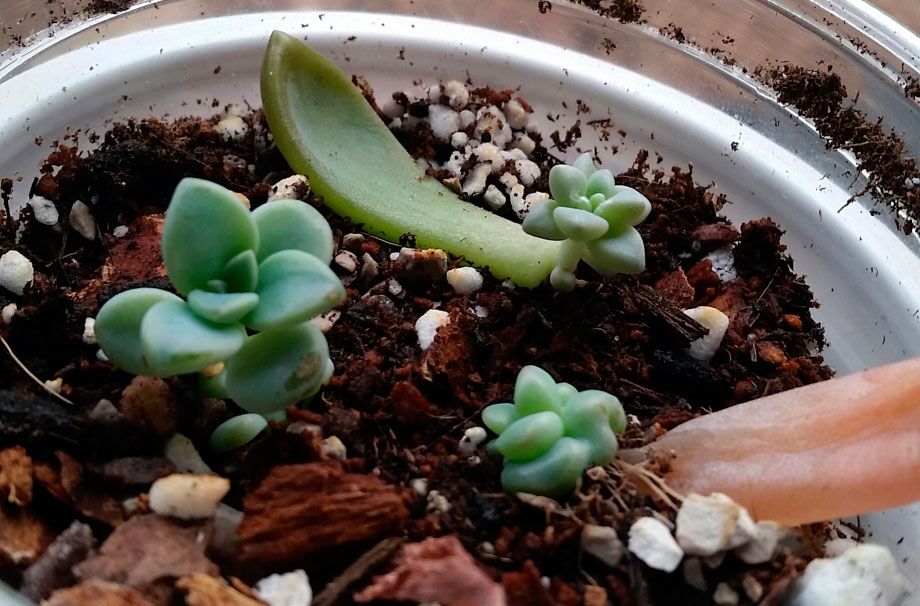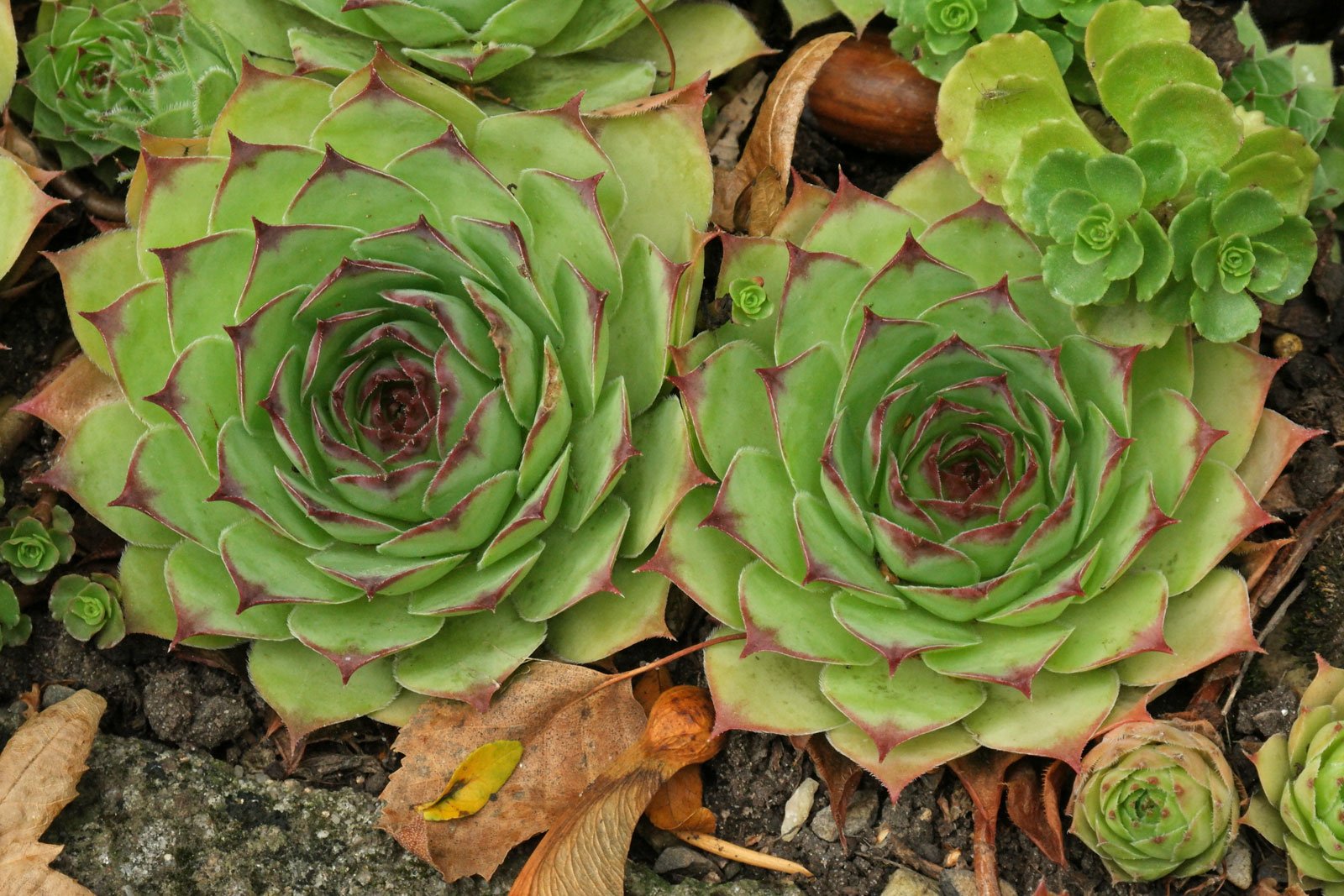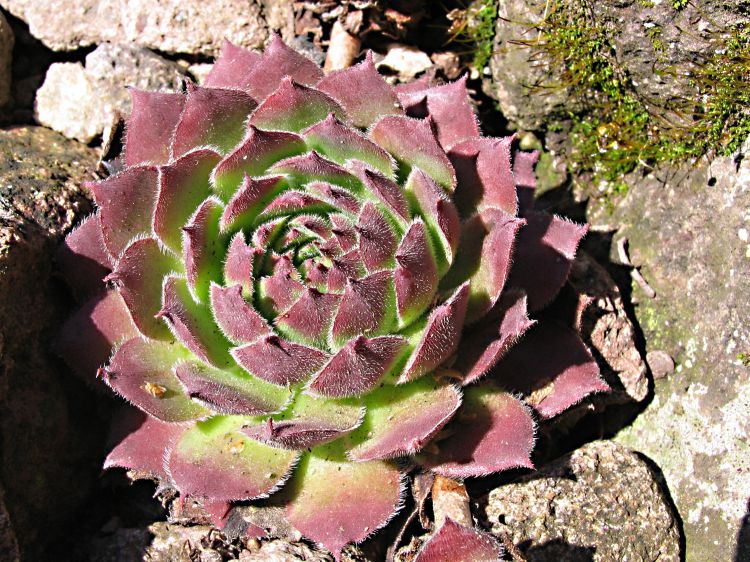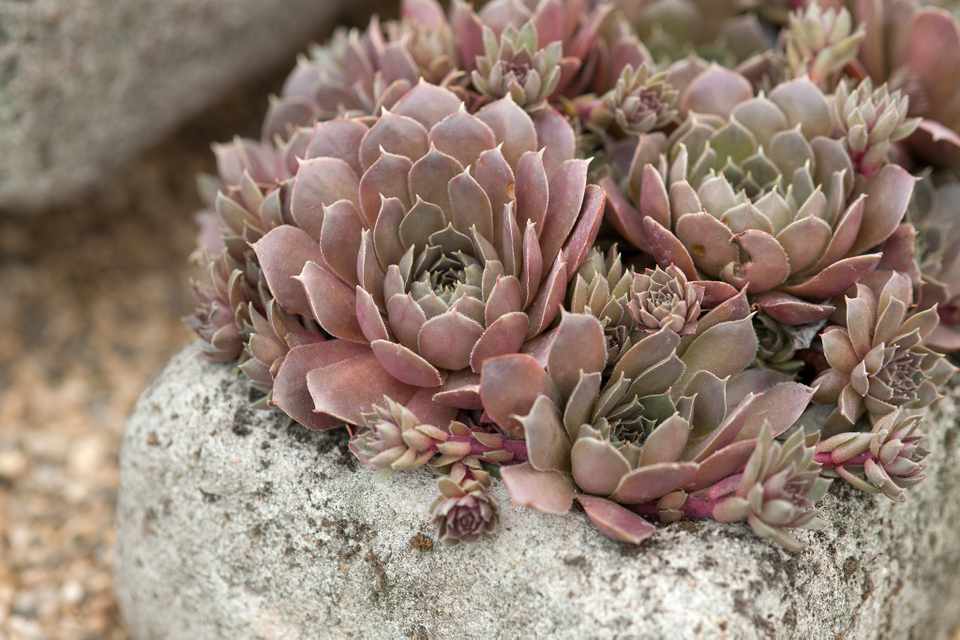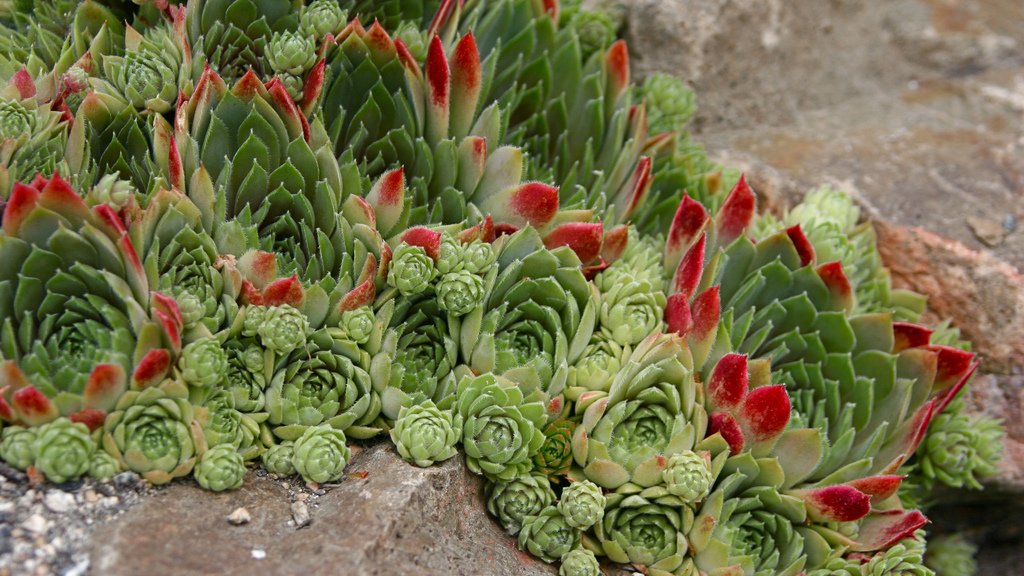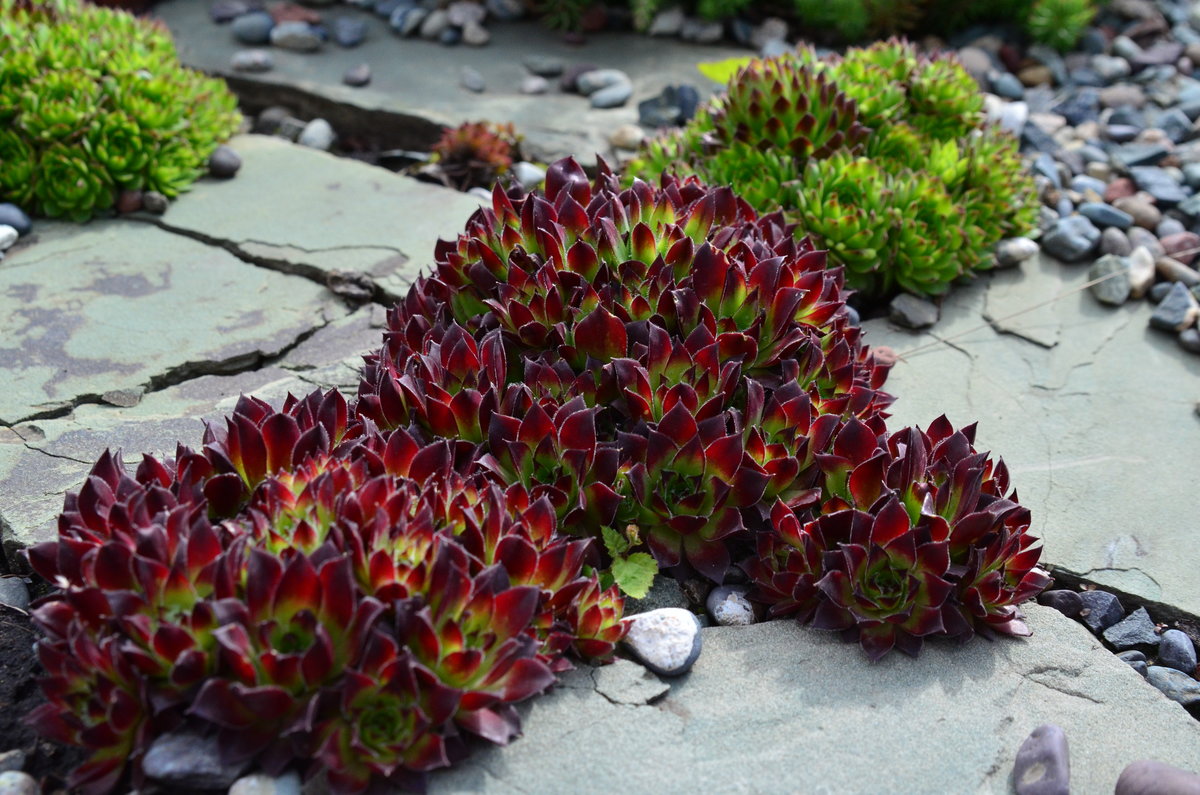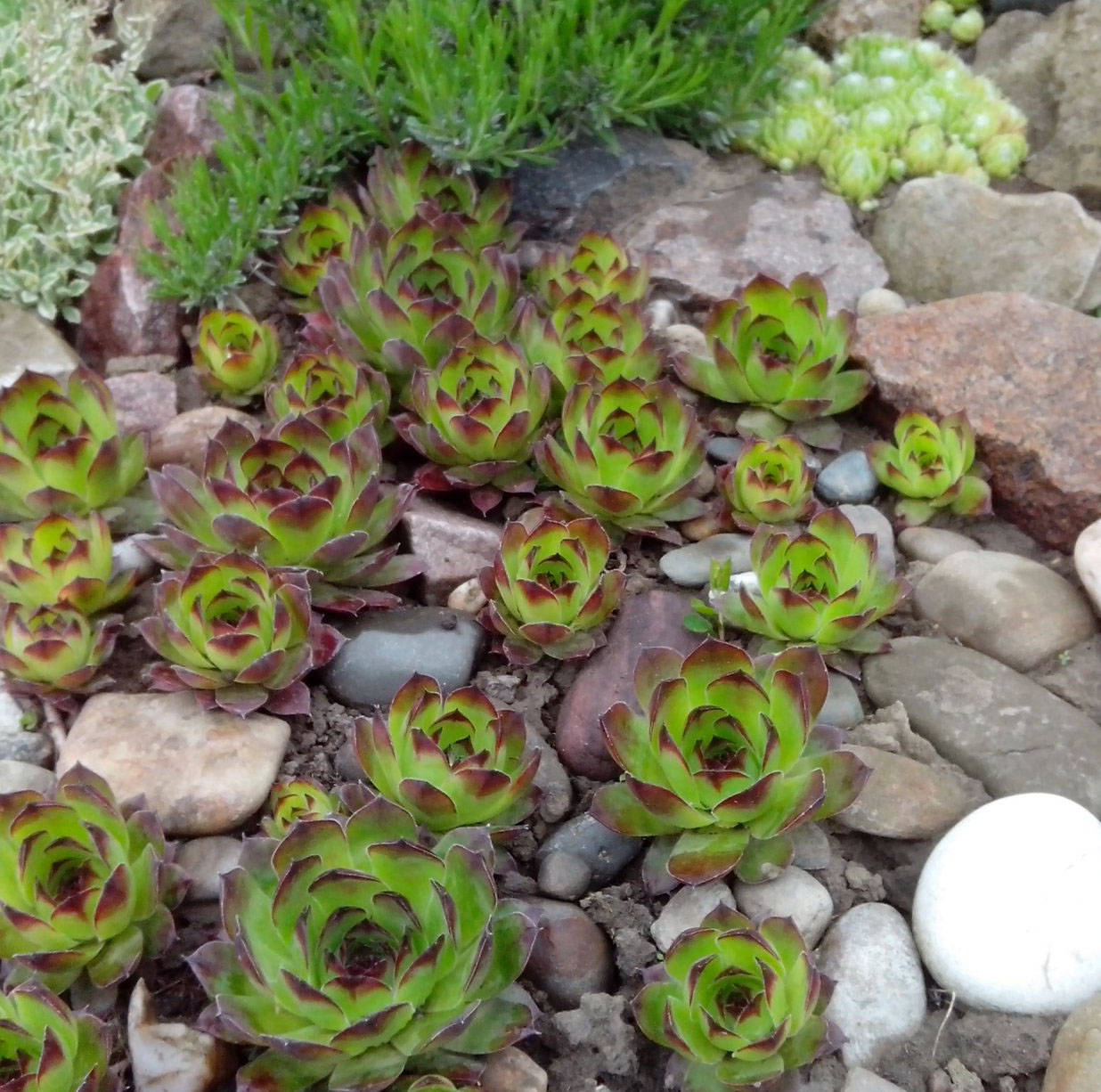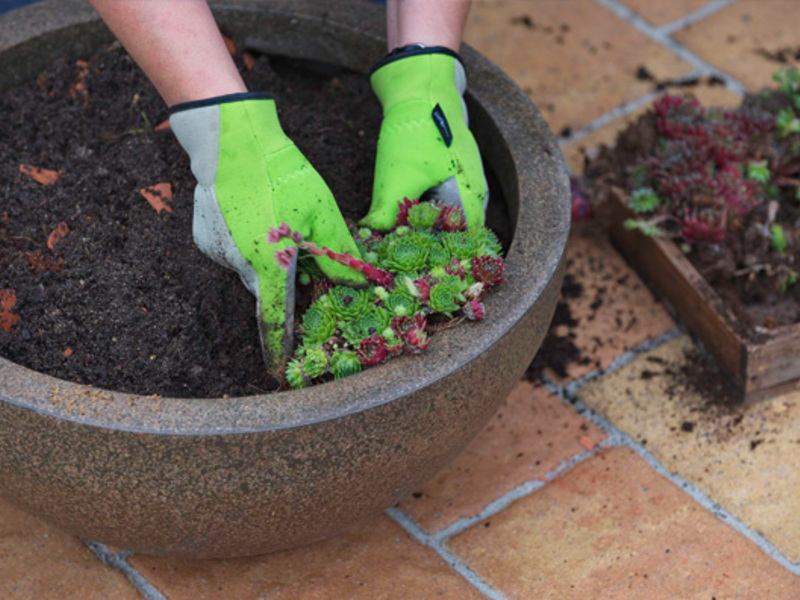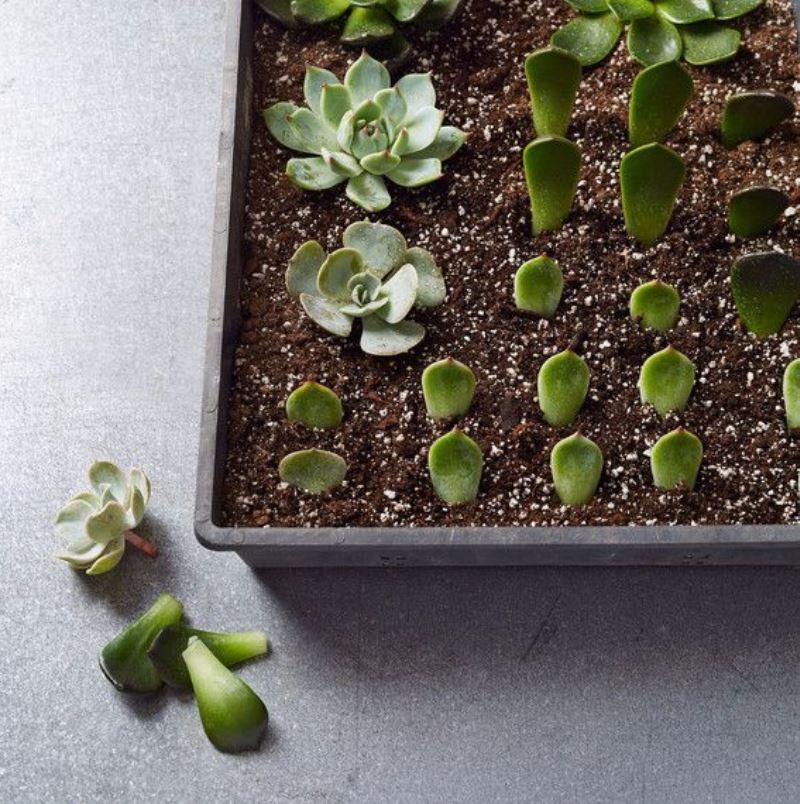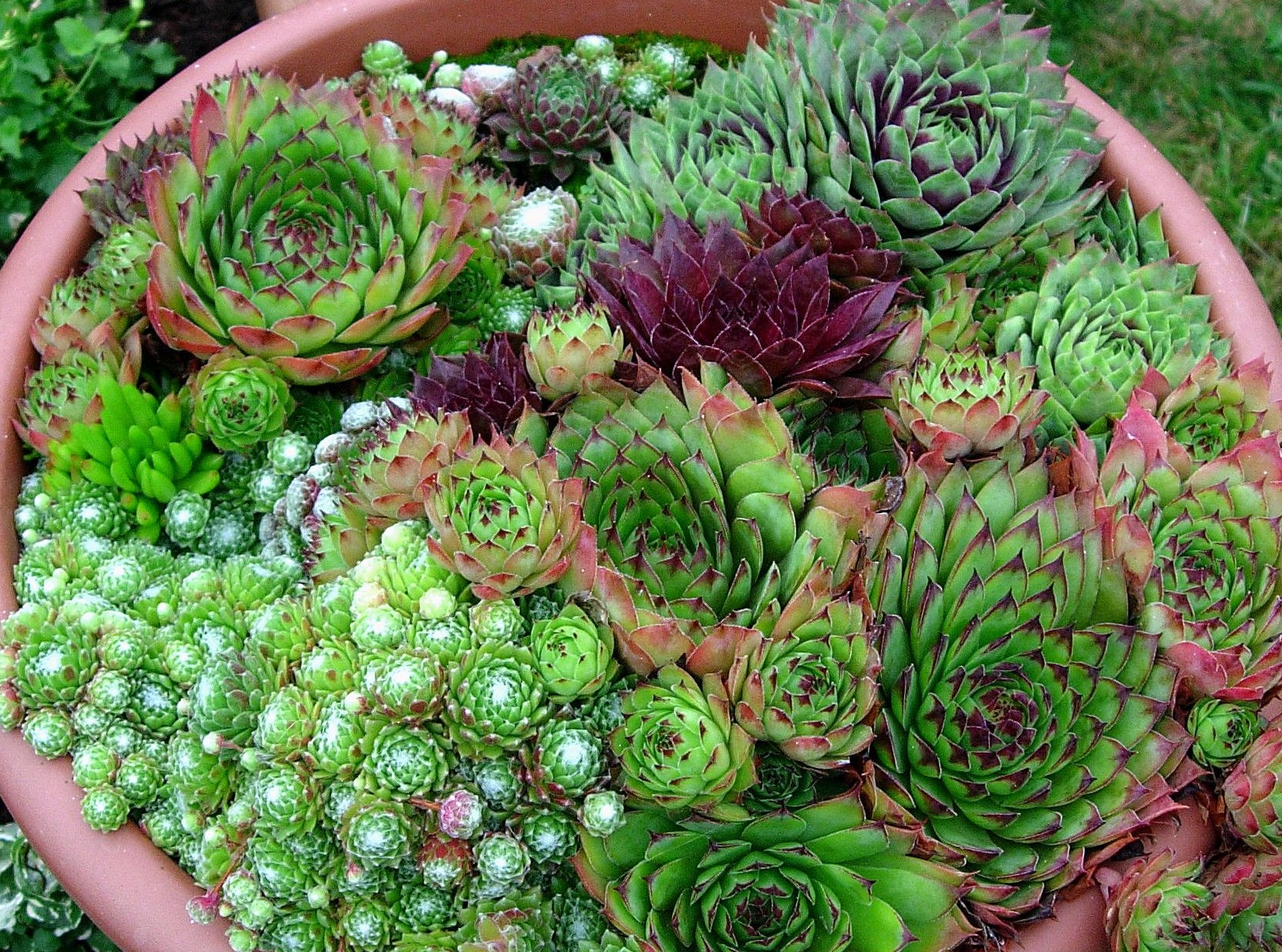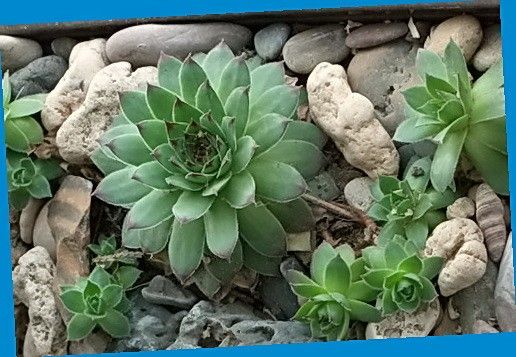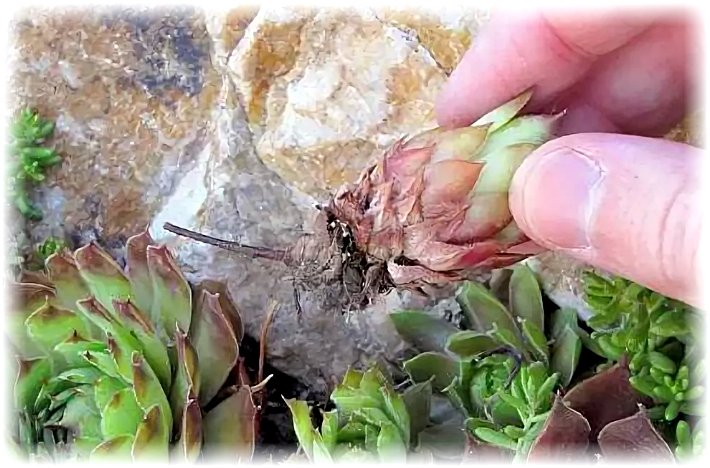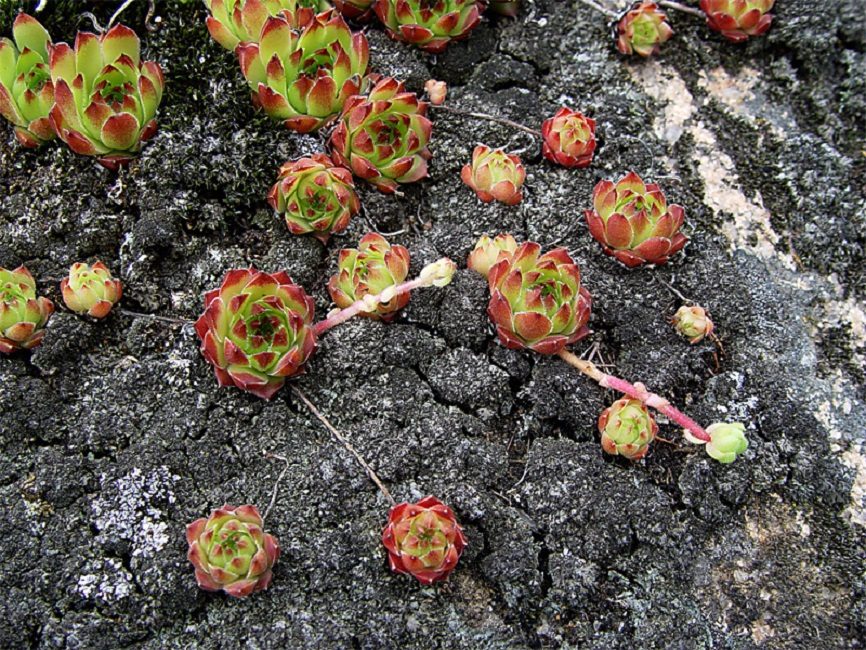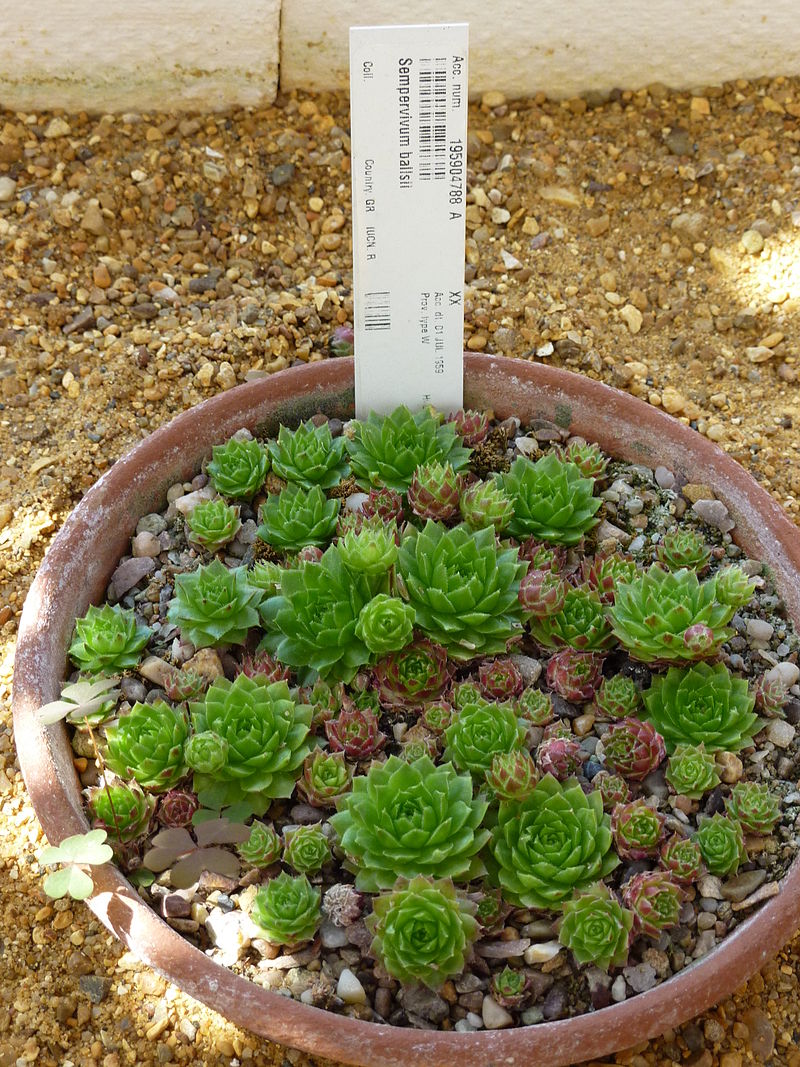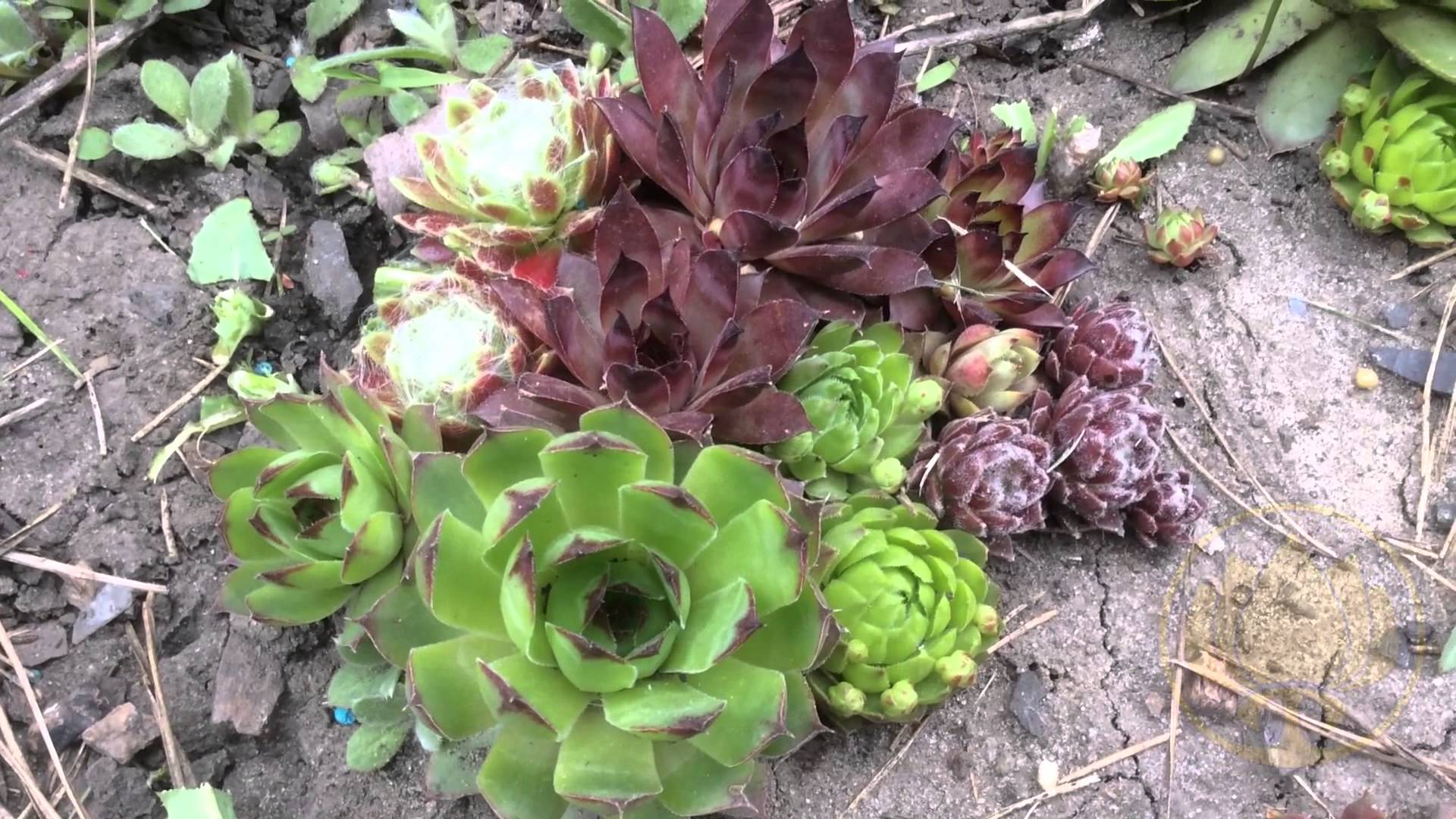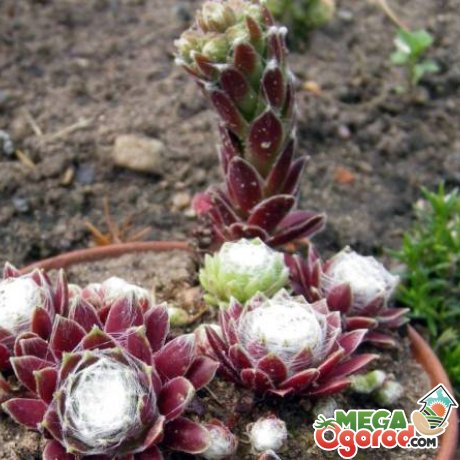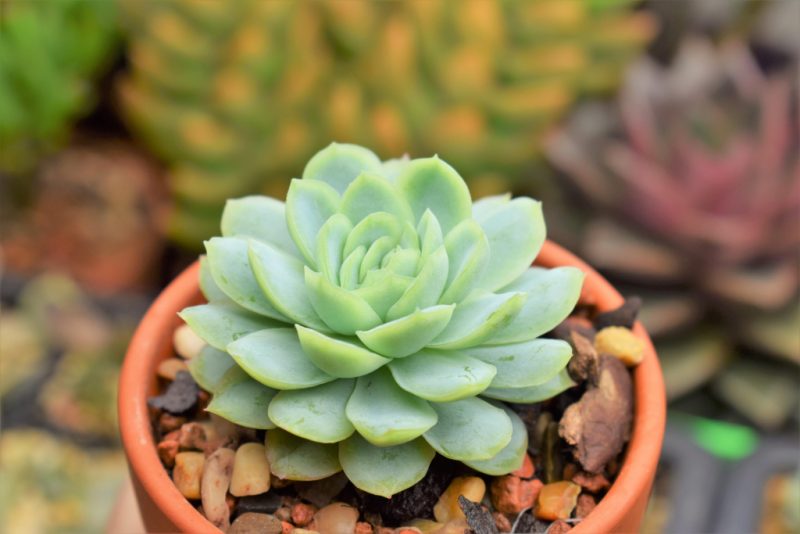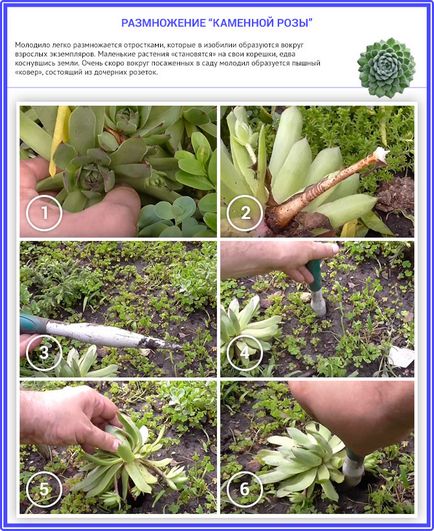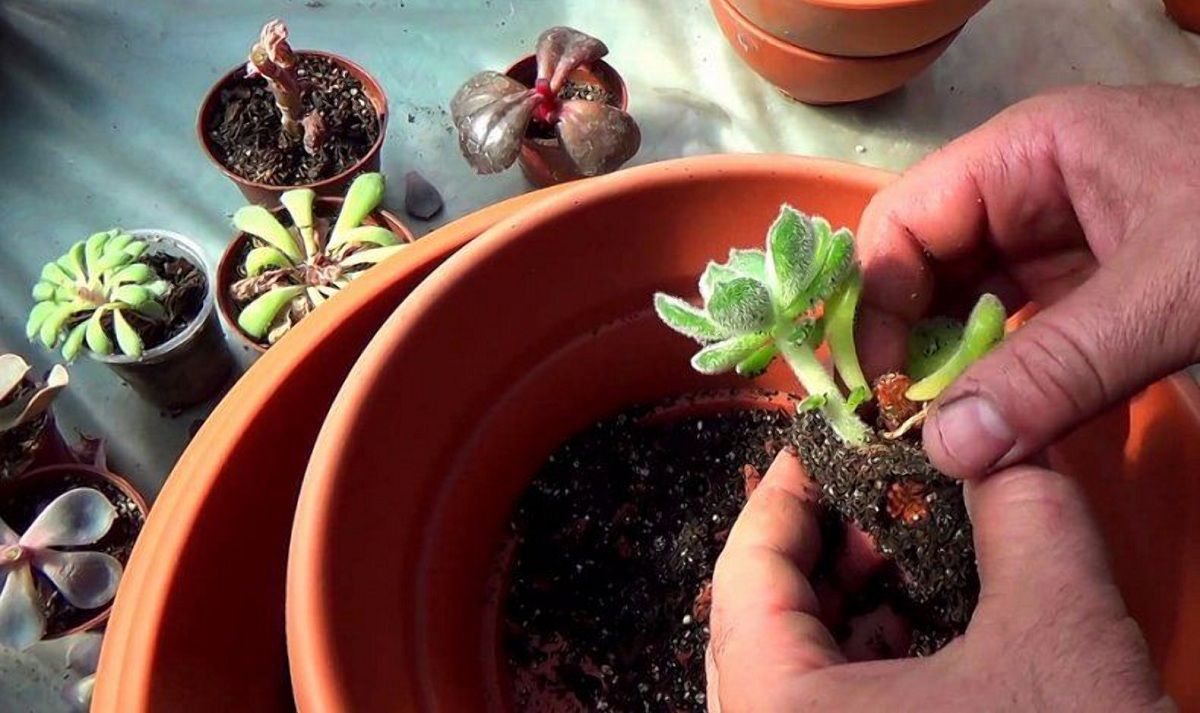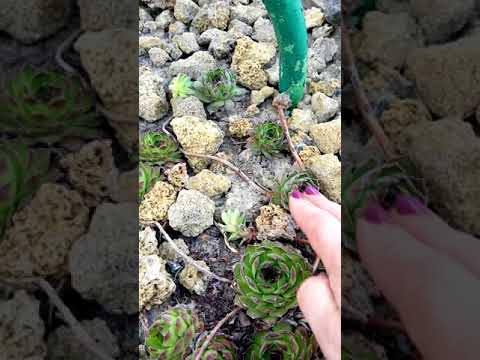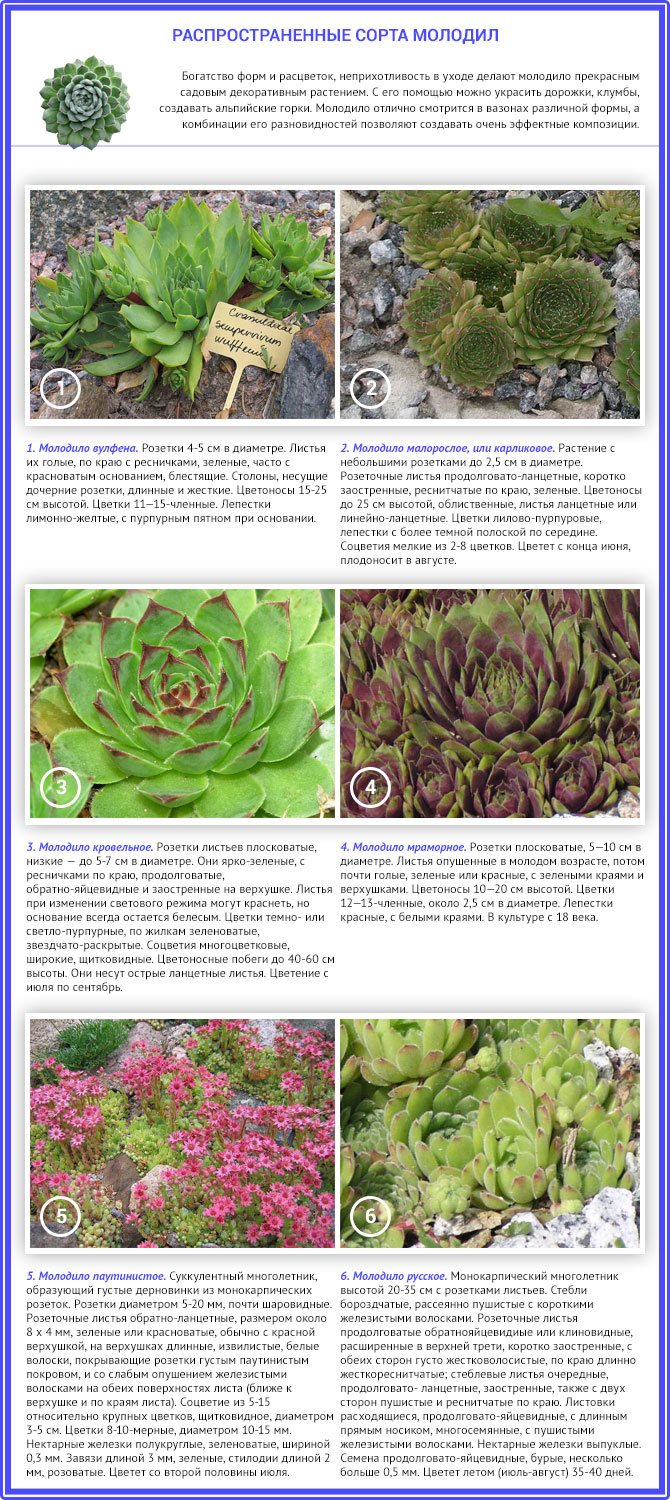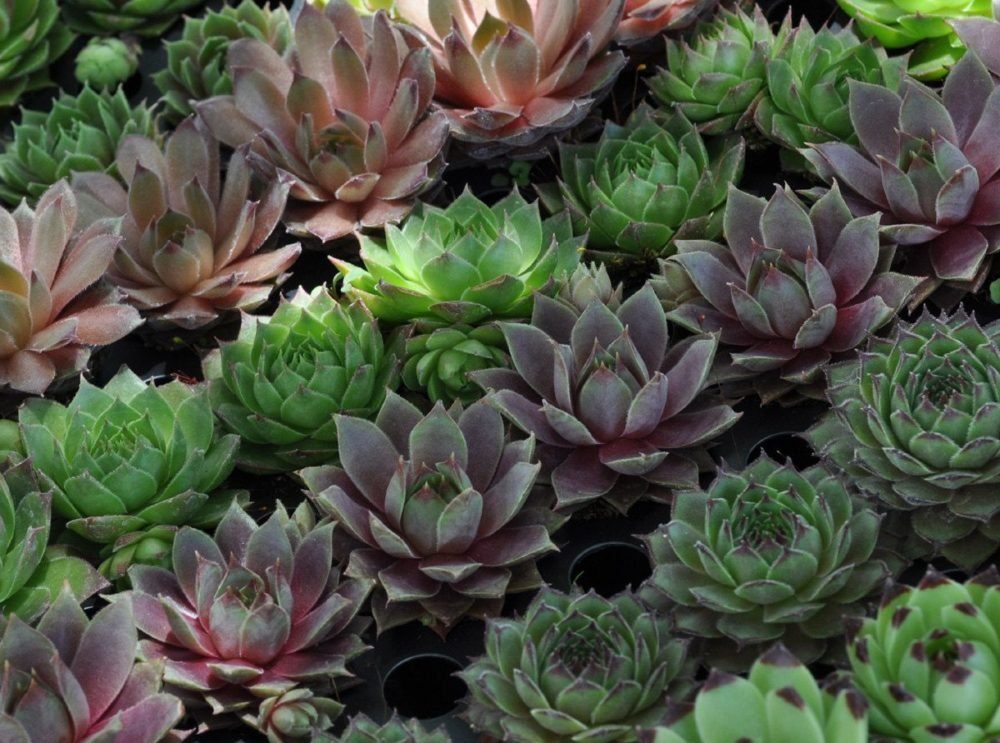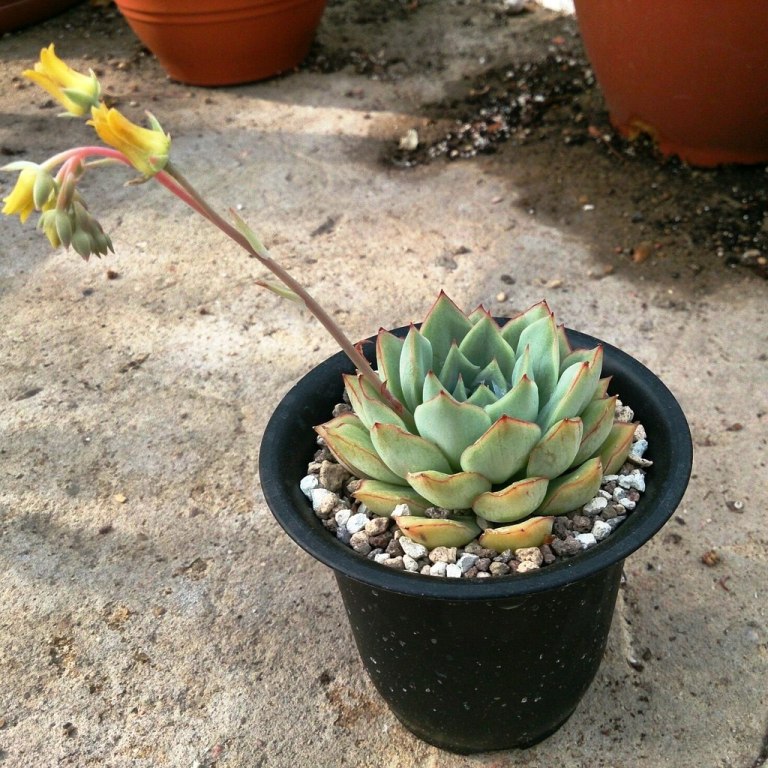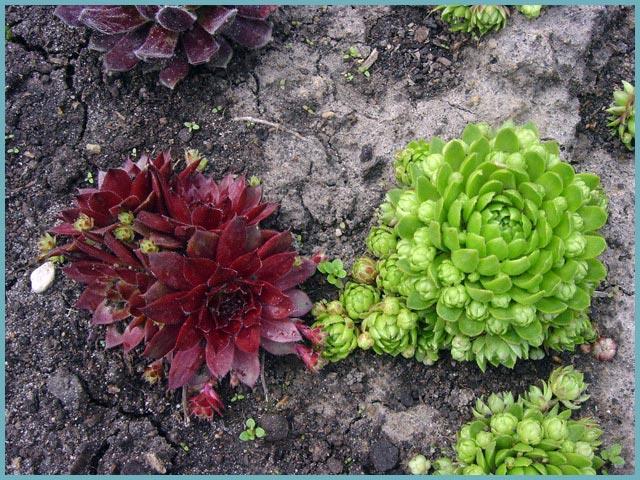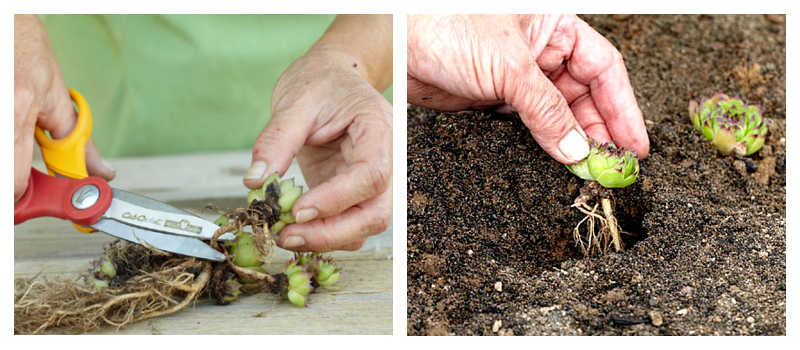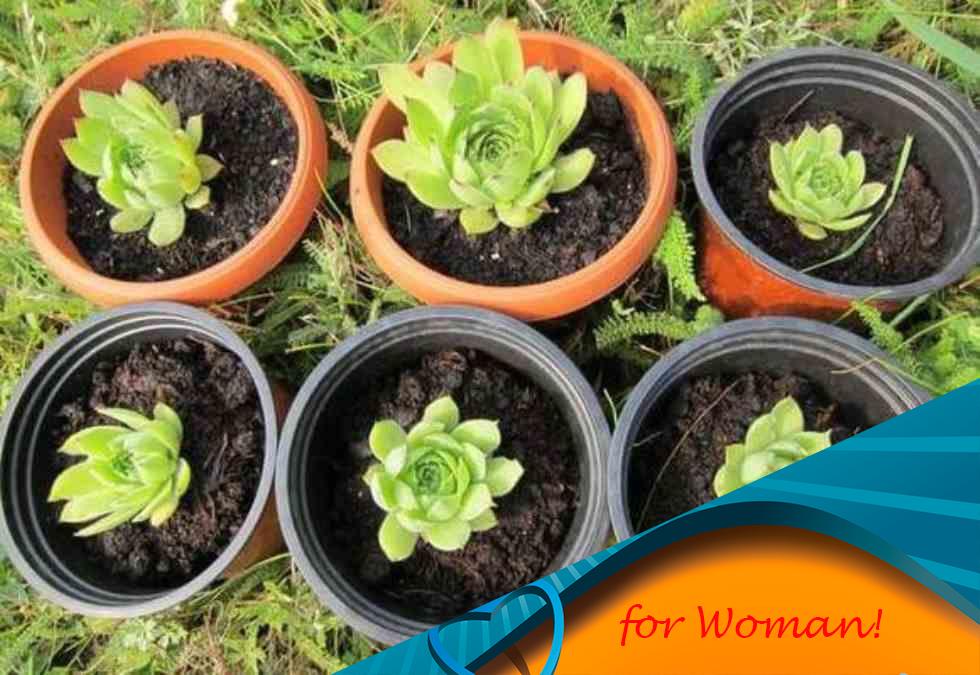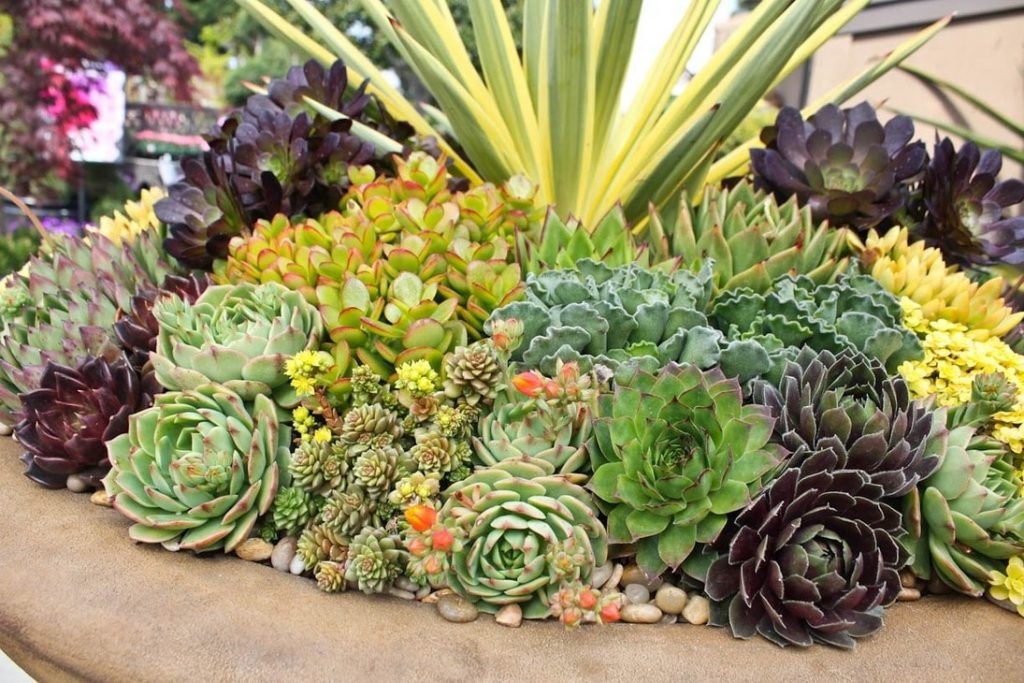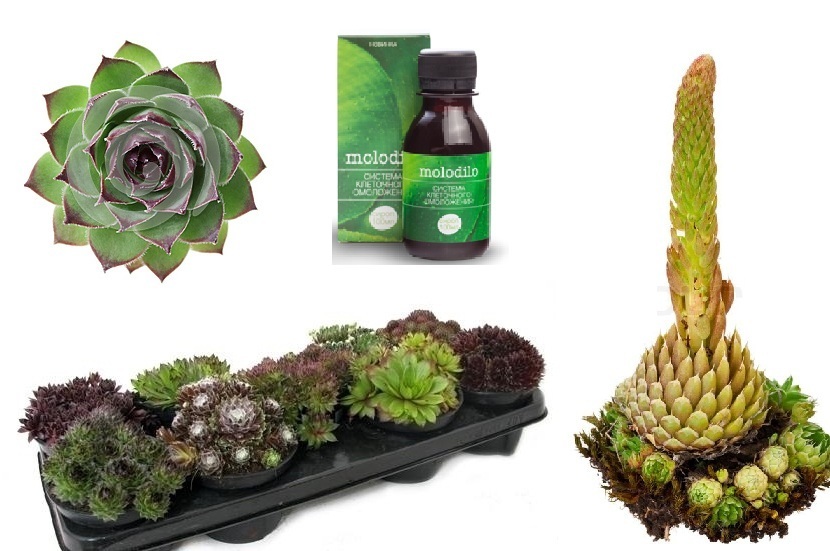Primary landing and transplant of Echeveria
After purchasing echeveria, some growers recommend immediately replanting the plant from the transport soil, since it is not intended for plant growth. Experienced succulent lovers say that nothing will happen to the plant in a month in the transport soil, this time will give the flower an opportunity to acclimate, survive stress, and get used to new living conditions.
Set the pot aside in a slightly shaded place and dry until aerial roots begin to appear. This is especially true of imported flowers (Dutch women). Sometimes stone roses do not survive the move and disappear for no apparent reason. Plants grown in local nurseries tolerate changes more easily.
Usually, this material is of higher quality and more expensive. Nevertheless, and he should dry up on the window. What soil mixture to plant echeveria in? In its natural environment, it is a rocky desert, where water does not retain at the roots. This should also happen in a pot. The substrate must be mixed with small pebbles, broken brick, gravel (fraction 3-5 mm).
Several options can be recommended:
- garden land - 3 parts,
- small pebbles - 1 part,
- peat - 1 part,
- charcoal - a little;
or:
- substrate for cacti or succulents - 4 parts,
- pebbles - 1 part;
Clean fine gravel plus some cialite can be used (if slow plant development is needed). It is easy to check a correctly mixed soil mixture - a lump of soaked substrate, squeezed in a hand, crumbles after unclenching.
Choosing a pot for a stone rose is a simple matter. You know the approximate diameter of the plant, take a pot 1-1.5 cm larger, flat (to match the root system) with many drainage holes. Small planting material can be planted in small cups for growing, and then transplanted to a permanent place.
A large pot or bowl is used for group planting of one or different types of echeveria. So that water does not stagnate in volumetric containers, they need to be watered with special care.
At the bottom of the pot we fill in the drainage, a little substrate, place the plant and fill it with the substrate along the root collar. If planting in clean gravel, then close the bottom by a third with pebbles, place the seedling and fill the remaining volume with them. This method is very simple, economically justified, since the stones serve forever and perfectly aerate the roots. There is one warning - for large plants we use gravel of a larger fraction.
We transplant small roses once a year, as we grow, we select a larger pot. Mature plants - every three years (as needed).
Reproduction of echeveria by a leaf
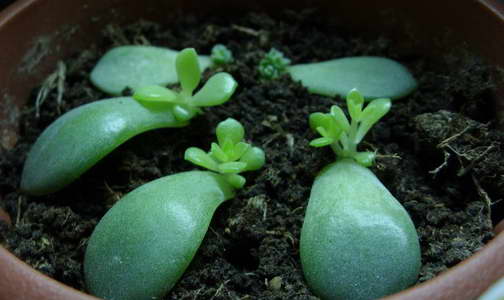
How to propagate echeveria with a photo sheet
A succulent plant reproduces without problems by a leaf, and the process does not present any particular difficulties.
Root the echeveria leaf in the soil mixture:
- you need to break off the bottom healthy sheet;
- dry for 2-3 hours;
- soil mixture (earth to sand 2: 1), perlite on top (2 mm), poured into a container;
- press the sheet at an angle;
- spray the soil with a spray gun and cover the container with foil;
- the greenhouse should be ventilated daily and moistened as the topsoil dries,
- the optimum temperature for rooting is 25 degrees Celsius;
- after 15-20 days, children will grow around the leaf;
- a new plant can be replanted when the mother leaf dries up.
Surprisingly, propagating Echeveria by a leaf can be even easier:
- separate the bottom large, bold sheet;
- put in a warm shaded place;
- you should wait quietly for about a month (+/-);
- roots and small rosettes will appear on the sheet;
- after which you should plant young plants in a pot.
We must be prepared for surprises, because on some sheet several children will develop, and on the other not a single one (and this happens). Experiment with which way you like the best will give the best results.
Plant propagation
An increase in the population of "quarries" on the site is possible in 3 ways - by seeds, cuttings, children. Growing from seeds is the most painstaking and therefore unpopular type of reproduction.
In its natural environment, in the garden, the plant reproduces beautifully on its own without the help of a gardener. The mother's rosette forms a baby, which then takes root near it, forming a beautiful “carpet” of young plants.

Reproduction by cuttings occurs as follows: a leaf is separated from the mother bush, then the cutting is dried, planted in the soil. Throughout the year, the seedling is formed into a full-fledged plant.
Landing
The plant is very unpretentious. It grows even on stony and poor soils.
You can propagate it:
- seeds;
- vegetatively.
Seeds
It is quite difficult and difficult to propagate rejuvenated seeds by seeds. Only fresh seeds are suitable for planting, otherwise the result may tend to zero.
It is best to use the seeds soon after harvesting or purchasing. Harvested seeds, to maintain freshness, are recommended to be stored in tightly closed containers. Thus, they will be protected from moisture.
The seeds are very small. Because of this, they are easily washed off and blown off the soil. Therefore, the technology of planting seeds should be strictly observed.
You can find out more about growing young from seeds here.
In open ground
- First you need to prepare the soil at the sowing site.
- The soil must be well loosened, weeds and their roots must be removed.
- For sowing, small indentations are made at a distance of about 4 cm.
- After sowing, the seeds are not poured from above, but poured with water from a spray bottle and lightly crushed.
About planting and caring for young people in the open field, as well as about suitable varieties, it is said here.
Indoor conditions
- The soil is poured into a shallow wide pot. If the soil is mixed independently, then it should contain limestone, charcoal, peat, sand. From ready-made soils, mixtures for cacti are used. The soil is covered with a layer of 5 - 10 centimeters.
- The soil is compacted and moistened with plain water or root. Slightly compact and sow seeds. They are planted at a shallow depth and sprinkled with a light substrate.
- The container is covered with glass or transparent film. Then the pot is placed in a bright place with a constant temperature of about 20 degrees.
- The soil is kept constantly moist and aired daily.
- After 2 weeks, the film (glass) is removed. Seedlings are dived and transplanted into other pots.
Watch a video about how rejuvenated is grown by seeds:
Children
A simple and affordable way is the main natural way of plant propagation. Therefore, to quickly increase the number of outlets, it is recommended.
Outside
- Choose a sunny place for planting. At this place, the soil is prepared. The soil is cleaned of weed roots, loosened and watered. If the soil is heavy and "greasy", then remove 5 - 10 centimeters of soil. A peat-sand mixture is poured into the formed groove - one part of peat is added to three parts of sand.
- Rosettes with a mustache and a lump of earth on the roots are separated from the mother plants. The sockets should already be rooted.
- Sockets are planted at a distance of 10 - 15 centimeters by simply pressing into the ground along with a lump of earth on the roots. There is no need to worry about the roots - they will not suffer. Drip the free end of the mustache and gently water it, preventing water from getting on the plant itself. If this is not done, then the rooting and development time will increase significantly.
- Further care is to remove weeds from the soil between the plants. When the young grows enough, they begin to care, as for adult plants.
Houses
- Prepare the soil for planting children. The best option would be soft and loose soil with a high sand content. You can also use specialized cactus soil.
- Next, add charcoal and expanded clay to the ground. The bottom of the planting container must be drained. The height of the drainage layer is 5 - 6 centimeters. Drainage is necessary to prevent stagnation of moisture in the pot.
- Immediately before planting, you can treat the roots with an agent to enhance their growth. Thus, accelerated rooting is achieved.
- Plants are planted in shallow holes at a distance of 5 - 10 centimeters. The roots must be completely immersed in the hole. Sprinkle with soil on top and press down slightly.
- After planting, it is poured a little with a syringe under the very spine of future outlets.
- In the future, all care consists in moderate regular watering. It is recommended to alternate between plain water and a 0.5% fungicide solution.
Watch a video about how rejuvenated breeds by children:
You can read more about growing rejuvenated at home here.
The landing was young
Rejuvenated is a very good solution for creating various summer cottage compositions, decorating garden paths and cutting flower beds. A stone rose can grow not only in open ground, but also on a windowsill in a pot, since there are over fifty varieties and varieties of this plant.
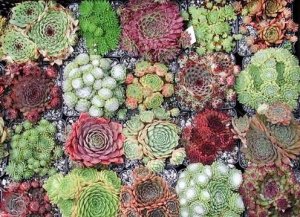
Rosettes of solid petals of this plant bloom only once a year. However, the flowering itself does not last long, only up to one week. The color of the flower can be very varied, which gives a special attractiveness to the carpet from the young. In diameter, the flowers can reach more than 20 cm, and in shape they are somewhat reminiscent of a stone rose. But in what conditions did the young people get used to growing?
Did you know? Another name was young - hare cabbage, which arose due to the similarity of some varieties with small heads of Brussels sprouts.
Temperature and lighting requirements
The stone rose simply surprises with its unpretentiousness to temperature conditions, since in summer it can grow without problems under the scorching sun, and in winter it can survive even in severe frosts down to -30˚С. Therefore, when choosing a place for rejuvenating in your flower bed, be sure to assign it the most illuminated place, which receives direct sunlight all day.
If you plant a stone rose in the shade, the plant will try its best to grow up to reach the sunlight. Unfortunately, this growth feature negatively affects the decorative properties of the flower, so it is better not to shade it.
Important! You should not plant the young near deciduous plants, since the flower will constantly cover its leaves, which can lead to its inevitable death.

But if you are growing or are going to plant a young one in a pot, then you should definitely put it only on the south side of the house, otherwise the plant will not delight at all with its beauty. In addition, airing should be done regularly in a room with a flower, and from the earliest spring to late autumn it is better to put the pot with it on an open balcony.
What soil is needed for a stone rose
In its natural environment, the young grows well on rocky mountain areas with sandy or clay soil. Therefore, if your flower bed has the same sandy light soil with a good drainage system in the form of fine gravel or stones, you will not even have to fertilize it additionally before planting a stone rose. The main thing is that the earth is not overly acidic, otherwise it can lead to poor flower growth.
In the same case, if you want to plant a stone rose in an apartment, you can purchase a complex soil mixture for planting cacti as a soil for it. But besides the soil, it also does not hurt to add a little charcoal to it, which will protect the root system from excess moisture and root rot.At the bottom of the pot, you can pour a little expanded clay, which will perform a drainage function. If the pot is large, one third of it can be filled with expanded clay.
How to plant a plant correctly
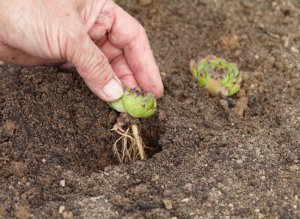
The flower rejuvenated for planting and care in the open field will be ready from the very beginning of spring until the last days of September. It takes root perfectly in any conditions, but nevertheless, it is recommended not to delay with an autumn planting, since the plant should still take root in a new place by frost.
If your plant for planting sits in a pot, it must be transferred into a prepared shallow hole in a flower bed right with a lump of earth that has adhered to its roots. If the root system of the plant is bare, it is simply pressed into the ground and a little sprinkled with earth on top. Since the root system of the young is very small, the plant can also be planted on artificial pedestals, where there is a very shallow layer of earth.
However, despite the remark about the root system, during planting, it is necessary to leave a space of about 10-15 cm between the plants. will take up all the space left.
Important! After the rejuvenated flower begins to dry out, it must be removed from the plant. Otherwise, together with the flower, the outlet itself will begin to dry out, which will lead to its death.
Pests and diseases
Rejuvenated are often affected by various types of rot. When the first signs appear, the plant must be transplanted into another pot or another place in the garden, cut the affected part and sprinkle it with charcoal. If the roots are affected, then it is better to simply destroy the diseased plant in order to avoid the possible spread of the disease.
Of the pests, garden plants affect the May beetles, which can eat up long passages in the pulp of the young. Plants must be carefully examined, damaged ones must be removed and transplanted to another place, and the old one must be processed to destroy the beetle larvae.
The young, growing on the windowsill, has two enemies: aphids and a worm. To destroy them, you need to use chemical preparations: "Inta-vir" helps well against aphids, and "Aktelik" helps against aphids.
You can plant different types of youngsters in pots to make a multi-colored carpet. The combination of rejuvenation and stonecrop also looks good.
The flower rejuvenated has not only an interesting decorative look, but also useful (medicinal) properties. It serves as an anti-inflammatory agent (medicine), treats stomatitis, stomach ulcers, diarrhea. Eliminates corns, warts and hemorrhoids. It removes age spots and freckles.
Varieties of an exotic flower
 More than 700 species of this culture are known in the world, about fifty of them grow in Russia. Among these plants there are a lot of hybrids practically indistinguishable from each other. Flowers can vary in color and shape depending on the time of year and the conditions in which they have to grow.
More than 700 species of this culture are known in the world, about fifty of them grow in Russia. Among these plants there are a lot of hybrids practically indistinguishable from each other. Flowers can vary in color and shape depending on the time of year and the conditions in which they have to grow.
Popular varieties of stone roses include the following plants:
- Roofing. The most common species was rejuvenated. In the wild, it can be found in Western and Eastern Europe, Asia, Africa. This plant is sometimes used to decorate the roofs of private houses. The rosettes of the flower are in the shape of a ball and in cross-section can reach from 8 to 16 cm. Its leaves are juicy and dense, elongated, brown-red in color in the upper part. The plant begins to bloom in early August, with pink-red inflorescences, which are located on long peduncles.
- Russian. This species grows in Asia Minor, as well as the steppes and forests of our homeland. The leaves are light green and oval in shape with a taper at the end. Rosettes can reach a diameter of 6-7 cm. Flowering begins in summer and lasts for 1 month. At this time, small yellow buds appear on the plant.
- Wolfen.This variety is often found in the Alps, as this flower prefers the rocky and mountainous regions of Europe. Green leaves are colored light red at their base and form small rosettes, about 4-5 cm in diameter. Shoots are quite tough and long. In summer, buds of a yellow-burgundy color appear on the peduncles.
- Cobweb. It grows in large quantities in the mountains of Europe, as well as in the North Caucasus. The plant got its name due to the presence of fluff on the leaves, which strongly resembles a cobweb. Small rosettes have a round shape, in summer they are green, and closer to autumn they acquire a burgundy hue and are covered with fluffy threads. In July, bright red inflorescences form on the peduncles, which delight the eye with their beauty for a month.
- Marble. The leaves of this succulent are colored pink and green with a white border around the edges. With the onset of winter, some plant varieties turn completely red. In a young rose, the foliage is covered with a light fluff, and in an adult flower, it has a smooth surface.
- Dwarf or Small. This was young - a plant of a very small size. The diameter of its rosettes does not exceed 3 cm. The leaves are pointed, pinkish-green in color. The plant blooms with dark red buds with a lilac tint. Its favorite place of growth is the rocky mountains of the Caucasus and the Alps.
- Spherical. This flower is found in the mountainous regions of the Caucasus and Turkey. Its leaves are light green with red tips. The rosettes of the plant are small, about 5 cm in cross section. Flowering lasts from July to August, at this time yellow buds bloom on the spherical rejuvenation.
- Limestone. A very effective variety of a stone rose. The flower has thin, pointed leaves of green-blue color with dark brown ends. The plant blooms in the middle of summer, with beautiful inflorescences of a light pink hue.
- Escaping or Offspring. This type of rejuvenation is widespread in the pine forests of Europe and Russia. Small rosettes are spherical and 4-5 cm in size. Leaves are fleshy and elastic, green in color with sharp ends. The plant blooms from July to August, with greenish-yellow flowers.
- Mountain. The rosettes of the plant are small (about 3 cm) and light green in color. Its flowers are lush and delicate, painted in a pink shade and arranged in small groups. A succulent of this species is often found in the forests of Eastern and Western Europe.
- Caucasian. The foliage of this flower is bright green with dark tips. The flowering period begins in mid-summer, at which time purple-red inflorescences appear on the plant. This sort of young grows well in the mountains of the North Caucasus, on soil strewn with stones.
In natural conditions and on the garden plot, rejuvenation is able to grow rapidly, covering large areas of the earth with a flowering carpet. Therefore, many growers are happy to grow this plant for decorative purposes, moreover, the flower is quite unpretentious and it is absolutely easy and pleasant to care for it.
Use in landscape design
Due to its unusual appearance, unpretentiousness to living conditions, as well as its color variety, landscape designers and owners of garden plots fell in love with it.
An incredibly popular combination was rejuvenated with a stone. A large boulder surrounded by "stone flowers" will look very beautiful. However, the plant is most actively used as a decorative element in rockeries and alpine hills.
It is also planted in pots located one above the other at an angle, thereby creating the effect of flowing water. They are decorated with paths or ladders on both sides. They are also used as a decoration for various statues and figurines.
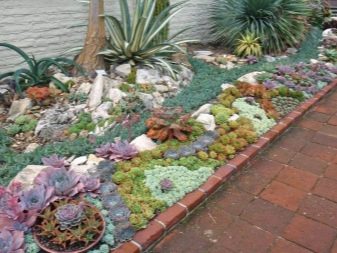

You can simply plant the young in the flower beds in the garden along with other flowers.A solid carpet of "stone flowers" of different colors looks beautiful, creating the appearance of a flower sea. Most often, rejuvenated is combined with stonecrops, saxifrage, arabis, antennae and moss.
Rejuvenated - not only a beautiful plant, but also a useful one. It has a wide range of medicinal properties: it is able to relieve inflammation, relieve pain and heal wounds. This is another reason to grow young on your site or windowsill, especially since this is not difficult to do.
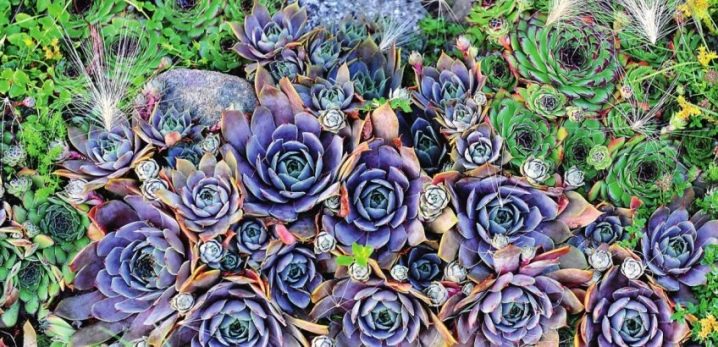
For even more about the features of growing young, see the next video.
1 Types of stone roses
Types of stone roses differ in color, size and shade of flowers, rapid growth of leaves. The structure of the rosettes, the rate of reproduction, the height of the peduncles and the time of flowering are also different.
The following types of stone roses are known:
- 1. Spiderweb was young. The plant is called so because of the small villi in the middle of the rosettes, which are very similar to a cobweb. It differs from other species in that it has very small, up to 2 cm in diameter, processes.
- 2. Hybrid rejuvenated. All hybrid varieties are united in this group. Plants have an unusual rosette shape, pubescence and color. There are burgundy, gray, silver, pink, red, bronze colors, all shades of green. The green-leaved form with a red tip is the most common color of rosettes.
- 3. Roofing was rejuvenated. Spherical rosettes, slightly flattened, up to 20 cm in diameter, pubescent, brownish-bronze in color or partially purple colored. Blooms in July-August for 40-45 days.
- 4. Marble was young. Rosettes are flat, up to 5-10 cm, pubescent at a young age. In adult plants, pubescence is absent, leaf blades are green or red with a green rim. Some varieties are brown in summer and red in winter.
- 5. The Russian was young. The only type of stone rose that grows in Central Russia. The plant reaches a height of 35 cm, which differs from other representatives of the genus. Rosette leaves and stems are covered with glandular hairs.
- 6. Globular rejuvenated. It occurs naturally in Turkey and the Caucasus mountains. The plant is oblong-spatulate, rosettes 5 cm in diameter, green with red tips. Blooms in July, inflorescences are yellow, umbellate.
- 7. Mountain was young. It has medium-sized, up to 3 cm, green pubescent rosettes and small pink inflorescences.
- 8. Small or dwarf juveniles. Grows in the Alps and on the slopes of the Caucasus Mountains, has dark green rosettes and purple inflorescences.
The stone rose blooms for a long time and profusely. Each shoot blooms only once, then it dies off, leaving behind many small rosettes.
Some gardeners mistakenly believe that rejuvenation and echeveria are one and the same. Plants are indeed very similar, but they have differences.
A more frost-resistant, unpretentious and hardy plant rejuvenated. It has a stem and has antennae; echeveria does not have such a feature. The leaves of the stone rose are thinner and more graceful, and both plants bloom differently.
You can also grow young at home.

3 Reproduction
Usually the stone rose is propagated vegetatively. Plants give a lot of rosettes, which are separated in spring or summer. The separated rosettes are rooted in moist soil, planting them at a distance of 10-15 cm from each other.
Rejuvenated can be grown from seeds. Sowing is carried out in late February - early March. Sow in a small container filled with a mixture of sand and peat. Seeds are sown on a compacted and damp surface, sprinkled with a thin layer of soil and covered with glass. The air temperature in the room is maintained at least 20 ° C. Care must be taken to keep the soil moist, but not wet. The room is ventilated daily.
Shoots appear in a week. The glass is removed when the seedlings are two weeks old and dive.
Young rosettes are planted in open ground in June.
Peculiarities
Latin Echeveria in Russian transcription is pronounced as echeveria or echeveria, and the people of the plant are known as "stone rose" or "stone flower". A herbaceous perennial from the bastard family belongs to succulents. Several plant species are native to South America. Some are found in the United States. But most of the 170 known species live in the vastness of hot Mexico.
Echeveria has the following features:
- the plant is stemless or with a stem up to 70 cm;
- some species have creeping shoots;
- the roots do not go deep, but grow superficially;
- leaves in some species are so dense, saturated with moisture that they resemble stone in hardness, hence the name "stone flower"; other varieties have flat leaves;
- leaf shape - oval with a sharp tip;
- the length of the sheet plate is up to 30 cm, and the width is up to 15 cm;
- leaves are collected in a dense or loose rosette, resembling a rose;
- the color of the leaves is striking in its variety: all shades of green, wine-red, violet-pink, bluish-gray;
- in different species, leaf plates are either pubescent, or with a bloom resembling hardened wax;
- the flower throws out a lateral or vertical peduncle up to half a meter in height;
- flowers - five-membered medium-sized bells up to 30 mm, collected in erect lateral inflorescences;
- the color of the peduncle is affected by illumination: from yellow in dim light to red-orange in bright light;
- Echeveria blooms in summer for one month;
- babies may appear on the stem of the peduncle.
Echeveria lends itself very well to selection, as a result there is a large number of interspecific and intergeneric forms. Hybrids have excellent decorative qualities and are a real home decoration. The plant feels great on a sunny windowsill, in a florarium or a greenhouse. It will calmly react to dry air, heat, but without light, the flower will look terrible. If there is not enough sun in the house, then it is better not to buy echeveria.
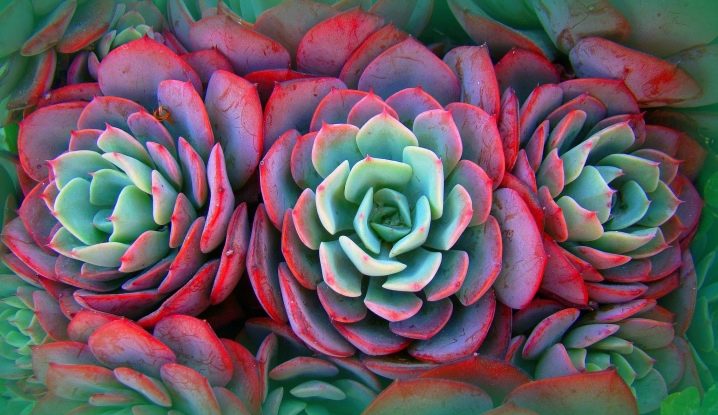
Types of stone rose
For garden plantings in open ground, rejuvenated is used, the variety of which is the most beautiful. In addition, the most frost-resistant breed lines are taken for street breeding. For example, roofing, which is widely used for decorating roofs in Europe and Scandinavia, was rejuvenated. According to various sources, there are from 30 to 50 species of stonecrop in the world (and many of its hybrid variations).
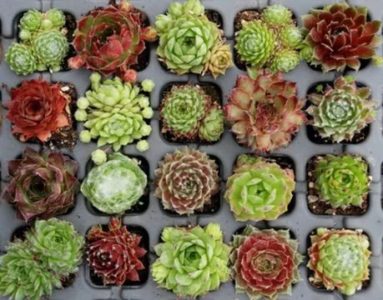
The most famous of them and cultivated in gardens and dwellings:
- 1 The Russian was younger. Perhaps the largest form of the survivors. The size of its peduncle reaches 40 cm in height with a relatively small diameter of 7-10 cm. The leaves are covered with hard hairs. The color of the plant is predominantly green, the flowers are yellow. Habitat - Asia Minor, Balkans, Central Russia.
- 2 Spherical. The rosette is 5 cm, the tips of the leaves at the ends are painted in red tones, the rosette is in the form of a volumetric ball, the flowers are yellow or yellow-green. Originally from Turkey, Central Asia and the Caucasus.
- 3Possal. A distinctive feature and feature of the plant: pubescence with a light "cobweb". The diameter of the head is 2.5-5 cm, the color is predominantly green, there is a variety - rubrum dark purple, which has reddish flowers. Grows in the mountains of Western Europe. Purple sedum does not tolerate subzero temperatures, therefore it freezes completely in winter.
- 4 Rejuvenated roofing. Rosettes are rounded and flattened, up to 15 cm in diameter, various colors: from green to red, including bicolor; grows in nature in the European part of Russia, Europe, Asia. It blooms with purple flowers.
- 5 The offspring was young. The rosettes resemble a ball in shape, medium-sized, up to 5 cm, yellow flowers. It grows in Europe and the European part of Russia.
- 6 Young Caucasian. Grows only in the Caucasus, large green rosettes (about 10 cm). It blooms very rarely with purple and purple flowers, which is why it almost does not bear fruit and reproduces mainly vegetatively.
- 7 Gornoye was young.Grows in the mountains of Western Europe, characterized by dark green medium-sized pubescent rosettes. Pale pink and with a dark inner rim, flowers on a high leg look contrasting.
- 8Lime stone rose. Hybrid, one of the most beautiful plant forms. Has refined, pointed leaves of a green-blue color, contrasting at the tip with black or brown; has a rosette of 8 cm. It rarely blooms, mainly with pink flowers.
- 9 Hybrid rejuvenator. A huge group of varieties with predominantly red colors. Very large hybrids "Othello" of dark red color and purple Commander Hay (over 15 cm), green-rosette bicolors of Jurin, Sassie Frass and Cousin Pacific Country, are widely known. The Cecar hybrid has a green-burgundy rosette and pink inflorescences; the flower rejuvenated the Sunset variety at the beginning of the summer season is bright green, and closer to autumn it radically changes its color to yellow with crimson edges.
Stone rose: varieties and types
To date, there are about 500 types of stone roses, of which more than 50 are perfectly adapted to our climatic conditions:
rejuvenated roofing - widespread throughout Europe. This species has a spherical-flattened rosette, which in diameter can reach from 7 to 15 cm, the leaves are fleshy, with pointed tips, painted in a reddish or brown-bronze color. Flowers are reddish pink;
the mountain was rejuvenated - a plant with a medium-sized rosette of green leaves and red-pink flowers. A hybrid of a young mountain - Brown's young is distinguished by flowers unusual for the species - with creamy yellow petals;
the Caucasian was young - it differs from other species by its rigid "cilia" on green leaves. The flower is red-purple or purple, stony soils are good for it, and fertilizers should contain a high percentage of calcium;
young dwarf - another name for small. A succulent plant with a very small, almost miniature (up to 2.5 cm in diameter) rosette, pointed leaves, with cilia at the edges. Flower - purple-red, in the center - a distinct stripe;
the marble was rejuvenated - its variegated leaves adorn green and red streaks (although there are varieties in which the rosette becomes almost completely red by winter), there is a slight pubescence on young leaves, but over time, growing up, the leaves become absolutely smooth. A flower with reddish petals with a light edging around the edges;
the cobweb was rejuvenated - probably the most unusual looking plant of this species. If you do not know, it may seem that the rosette has become a victim of some kind of pest - it is almost completely entangled in silky cobwebs. The rosettes are medium-sized, no more than 4 cm in diameter, the flowers are purple. In culture, many varieties and subspecies are known, all with rosettes pubescent to a greater or lesser extent (Fauconeta was younger). For normal development, a site with good drainage is needed, preferably calcareous or stony soils. In our conditions, it winters very badly on the soil, so in the fall it is better to transfer flowers to the house (to the loggia);
young scion (shoot-bearing) - has spherical (up to 5 cm in diameter) rosettes with fleshy green leaves, flowers are greenish or pale yellow, abundantly grows in pine forests on sandy soils. It has medicinal properties, it is used to heal wounds and in heart failure;
young Russian - a representative of the Russian forest-steppes, has been cultivated in culture since the 19th century, is distinguished by a large rosette with juicy green leaves, flowers are yellow.
Planting and care in the open field
Site selection and soil preparation
 The rejuvenator is very good at adapting to changes in the weather. The plant can withstand the heat of summer and severe frosts in winter. But in order for him to be comfortable and cozy in your garden, it is best to choose the most illuminated place for the flower on the site.It should be borne in mind that a rose grown in bright sun will have a small size and a rich shade of leaves, and in the shade the plant will be larger, but rather pale. Therefore, it is not recommended to plant it near shrubs and trees, since the shade from them can hide the succulent from the sun.
The rejuvenator is very good at adapting to changes in the weather. The plant can withstand the heat of summer and severe frosts in winter. But in order for him to be comfortable and cozy in your garden, it is best to choose the most illuminated place for the flower on the site.It should be borne in mind that a rose grown in bright sun will have a small size and a rich shade of leaves, and in the shade the plant will be larger, but rather pale. Therefore, it is not recommended to plant it near shrubs and trees, since the shade from them can hide the succulent from the sun.
Under natural conditions, the young prefers to grow on mountain slopes covered with stones, in soil containing a large percentage of clay and sand. To create similar conditions, this flower must be planted in light and sandy soil and be sure to provide good drainage. For this, small pebbles, expanded clay or small crushed stone may be suitable. It is not necessary to add fertilizer to the ground before planting, since the acidic environment can negatively affect the growth of the plant.
Planting a succulent
 Planting roses in the garden area should be carried out in the spring and summer, so that the plant has time to take root in a new place and is ready for the arrival of cold weather. First you need to prepare the soil: loosen well, remove weeds and dilute with sand or small pebbles. Then make small holes in it, where the seedlings will be planted. You can also plant the seeds of a plant, but then it will grow very slowly.
Planting roses in the garden area should be carried out in the spring and summer, so that the plant has time to take root in a new place and is ready for the arrival of cold weather. First you need to prepare the soil: loosen well, remove weeds and dilute with sand or small pebbles. Then make small holes in it, where the seedlings will be planted. You can also plant the seeds of a plant, but then it will grow very slowly.
The distance between the rosettes should be about 20 cm, so that later young shoots can grow freely. If you decide to plant a dwarf young, then it is better to leave a space of 5-7 cm between the flowers
Young plants need to be placed shallowly into the holes along with a lump of earth on the roots, then carefully cover with earth and lightly tamp. After that, the seedlings must be watered.
Plant care rules
Despite the peculiar and unusual appearance of the flower, caring for it is quite simple and does not take much time and effort. But in order for the plant to develop quickly and feel comfortable, caring for it, you must adhere to the following rules:
Watering the succulent is rarely necessary, since waterlogging of the soil will lead to decay of the roots. In the summer, it is enough once every 7 days, and in the winter only as needed.
It is very important to ensure that water does not get inside the outlets, as this can lead to leaf rot, especially with the onset of cooler days. To avoid negative consequences, water must be poured near the plant, its roots will absorb the required amount of moisture in any case.
It is imperative to periodically clean the soil from weeds around the flowers. Weed grass may prevent the plant from growing, so you need to make room for young roses. This should be done regularly and carefully, taking care not to damage the small outlets.
It is not required to feed the plant, since an excess of nutrients can affect the color and growth of the young, and also adversely affect its well-being. It is possible to apply fertilizers to the soil only 3-4 years after planting. For this, special mixtures for feeding cacti are suitable.
Air humidity for a flower does not matter. Therefore, spraying is not required for him, and in the hot season it can even harm, since water droplets can burn the foliage of the succulent. It is also not recommended to wipe the leaves, as they are covered with a special film that protects them.
Rejuvenated is a frost-resistant plant and can winter well under a snow cover. But it will be best to cover the flower during the cold period, especially if it was planted recently and did not have time to get stronger well. For this, you can use autumn foliage and coniferous branches.
It is not recommended to transplant an unusual flower, as it does not tolerate this process well.
But if necessary, you can carefully dig the plant out of wet soil and plant it with a lump of earth in a prepared place. It should be borne in mind that the young will not tolerate frequent transplants.

